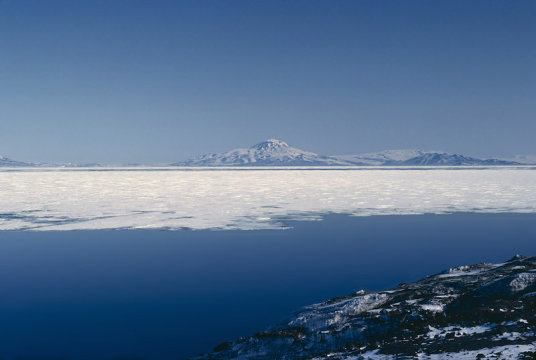[ad_1]
The ROSETTA-Ice project, a three-year, multi-institutional data collection survey of Antarctic ice, has assembled an unprecedented view of the Ross Ice Shelf, its structure and how it has been changing over time. In a study published today in Nature Geoscience, the ROSETTA-Ice team members detail how they discovered an ancient geologic structure that restricts where ocean water flows. The discovery suggests that local ocean currents may play a critical role in the ice shelf’s future retreat.
Ice shelves are massive expanses of floating ice that slow down the flow of Antarctic ice into the ocean. ROSETTA-Ice collected data from the massive Ross Ice Shelf, which helps slow the flow of about 20 percent of Antarctica’s grounded ice into the ocean — equivalent to 38 feet of global sea level rise. Antarctica’s ice is already melting at an accelerating rate. Predicting how the ice shelf will change as the planet continues to warm requires understanding the complex ways in which the ice, ocean, atmosphere and geology interact with each other.
To gain a better understanding of these processes, the multidisciplinary ROSETTA-Ice team approached the Ross Ice Shelf much like explorers visiting a new planet for the first time. The team faced the key challenge of how to gather data from a region the size of Spain, and where ice that is frequently more than a thousand feet thick prevents more traditional ship-based surveys of the seabed. The solution was IcePod, a first-of-its kind system designed to collect high-resolution data across the polar regions. IcePod was developed at Columbia University’s Lamont-Doherty Earth Observatory and mounted on a cargo plane. Its instruments measure ice shelf height, thickness and internal structure, and the magnetic and gravity signal of the underlying rock.
Each time the team flew across the ice shelf, the IcePod’s magnetometer (which measures Earth’s magnetic field) showed a flat and almost unchanging signal. That is, until halfway across the ice shelf, when the instrument came alive, displaying large variations, much like the heartbeat on a cardiogram. When the team mapped their results, it became clear that this “heartbeat” always appeared in the middle of the ice shelf, identifying a previously unmapped segment of the geologic boundary between East and West Antarctica.
The team then used IcePod’s measurements of Earth’s gravity field to model the shape of the sea floor beneath the ice shelf. “We could see that the geological boundary was making the seafloor on the East Antarctic side much deeper than the West, and that affects the way the ocean water circulates under the ice shelf,” explained Kirsty Tinto, the Lamont research scientist who led all three field expeditions and is lead author of the study.
Using the new map of the seabed under the ice shelf, the team ran a model of ocean circulation and its effect on ice shelf melting. Compared with the Amundsen Sea to the east, where warm water crosses the continental shelf to cause rapid melting of the ice shelves, little warm water reaches the Ross Ice Shelf. In the Ross Sea heat from the deep ocean is removed by the cold winter atmosphere in a region of open water, called the Ross Shelf Polynya, before flowing under the ice shelf. The model showed that this cold water melts deeper portions of east Antarctic glaciers, but it is steered away from the west Antarctic side by the depth change at the ancient tectonic boundary.
In a surprise twist, however, the team found that the polynya also contributes to a region of intense summertime melting along the ice shelf’s leading edge. This melting was confirmed in the radar images of the ice shelf’s internal structure. “We found that the ice loss from the Ross Ice Shelf and flow of the adjoining grounded ice are sensitive to changes in processes along the ice front, such as increased summer warming if sea ice or clouds decrease,” said Laurie Padman, a co-author and senior scientist at Earth and Space Research.
Overall, the results indicate that models used to predict Antarctic ice loss in future climates must consider changing local conditions near the ice front, not just the large-scale changes in the circulation of warm deep water. “We found out that it’s these local processes we need to understand to make sound predictions,” said Tinto.
The ROSETTA-Ice project partners include Lamont-Doherty Earth Observatory of Columbia University, Scripps Institution of Oceanography at the University of California San Diego, Colorado College, Earth and Space Research and GNS Science, New Zealand. Fieldwork was supported by the United States Antarctic Program and the New York Air National Guard, the New Zealand Ministry of Business Innovation and Employment and the New Zealand Antarctic Research Institute. ROSETTA-Ice is funded by the National Science Foundation, The Moore Foundation, and the Old York Foundation.
Story Source:
Materials provided by Earth Institute at Columbia University. Original written by Marie DeNoia Aronsohn. Note: Content may be edited for style and length.
[ad_2]















